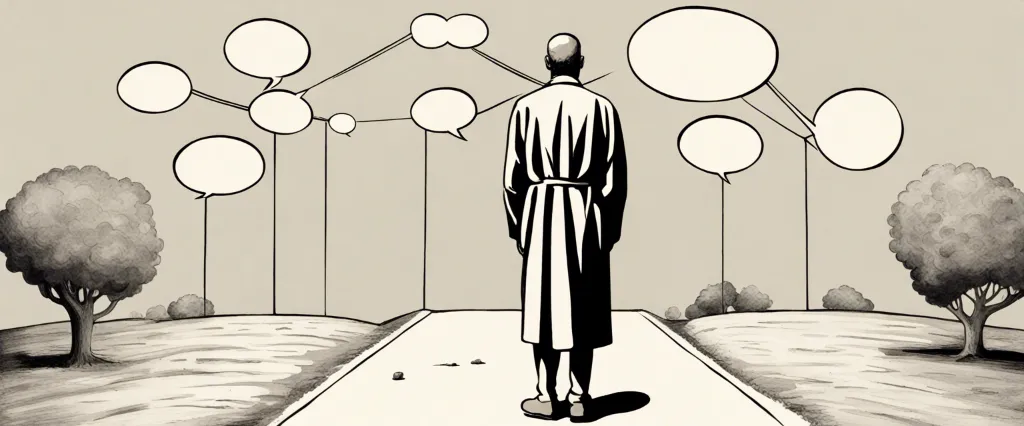In his book “How to Be a Stoic,” Massimo Pigliucci dives into the ancient philosophy of Stoicism, offering practical advice on how to apply its principles to modern life. Drawing from the teachings of great Stoic philosophers like Epictetus, Seneca, and Marcus Aurelius, Pigliucci provides readers with a compelling guide to embracing a more tranquil and meaningful existence. A professor of philosophy at the City College of New York, Pigliucci is widely recognized for his expertise in Stoicism and has penned several books on the subject, positioning himself as a leading modern-day authority on the ancient philosophy. With a blend of scholarly insights and personal anecdotes, Pigliucci illuminates the profound wisdom of Stoicism, demonstrating how its timeless teachings can profoundly improve our well-being and help us navigate the challenges of daily life.
Chapter 1: Introduction to Stoicism
In Chapter 1 of “How to Be a Stoic” by Massimo Pigliucci, the author provides an introduction to Stoicism, an ancient philosophy that offers a practical guide for living a fulfilling and meaningful life. Pigliucci begins by explaining the history of Stoicism, tracing its origins back to Greece in the 3rd century BCE and its subsequent development in Rome.
He highlights three key Stoic philosophers: Epictetus, Seneca, and Marcus Aurelius, each of whom contributed to the philosophy in their own unique ways. The author also mentions the appeal Stoicism has for individuals in modern times, as it offers practical tools for dealing with life’s challenges, enhancing self-improvement, and finding tranquility.
Pigliucci then presents the core principles of Stoic philosophy. He emphasizes that Stoicism is not about suppressing emotions or denying ourselves pleasures, but rather aims to achieve eudaimonia, or the flourishing of a human being. The Stoics believe that virtue is the highest good and that one should focus on cultivating personal character and moral excellence. They also emphasize the importance of accepting and embracing the things we cannot control, while focusing our efforts on what we can control: our thoughts, actions, and attitudes.
The chapter concludes with a brief discussion on the distinction between what is within our control (our judgments, desires, and actions) and what is outside of our control (external events and other people’s actions). Pigliucci highlights that Stoicism encourages us to shape our own character and be resilient in the face of adversity, rather than being victims of circumstance.
Overall, Chapter 1 serves as an engaging and accessible introduction to Stoicism, laying the foundation for the practical teachings and exercises presented in the rest of the book.
Chapter 2: The Stoic Philosophy of Life
Chapter 2 of “How to Be a Stoic” by Massimo Pigliucci provides an overview of Stoic philosophy, which serves as the foundation for the book. The chapter emphasizes the practicality of Stoicism, presenting it as a philosophy of life rather than a purely theoretical pursuit.
Pigliucci begins by explaining that the ultimate goal of Stoicism is to cultivate wisdom and virtue, enabling individuals to live a good life. He introduces the concept of “preferred indifferents,” which includes external things such as wealth, health, and reputation. Stoics believe that while these indifferents are not intrinsically good or bad, they should be pursued in accordance with reason and virtue.
The author highlights the Stoic dichotomy of control, emphasizing that we should focus only on things that are within our control, such as our judgments, actions, and attitudes. This detachment from external outcomes allows the Stoic practitioner to maintain peace of mind and resilience in the face of adversity.
Pigliucci explores a fundamental Stoic concept, the dichotomy of emotions, which distinguishes between healthy emotions (eupatheia) and unhealthy emotions (pathē). Stoics aim to cultivate emotions like joy, caution, and desire, while purging negative emotions such as anger, fear, and envy.
Another key principle discussed is the concept of “cosmopolitanism,” where Stoics view themselves as citizens of the world, connected to all humanity. This perspective promotes moral responsibility, empathy, and a sense of interconnectedness.
Overall, Chapter 2 provides an introduction to the essential Stoic teachings, focusing on a practical philosophy that aims to equip individuals with the tools to navigate their lives with wisdom, virtue, and inner tranquility.
Chapter 3: Developing Virtue and Moral Character
Chapter 3 of “How to Be a Stoic” by Massimo Pigliucci focuses on developing virtue and moral character using the principles of Stoicism. Pigliucci guides us through the Stoic understanding of virtue as the ultimate goal of life, emphasizing that external goods and social recognition are not lasting sources of happiness and fulfillment.
He explains the four cardinal virtues identified by the ancient Stoics: wisdom, courage, justice, and temperance. Wisdom involves acquiring knowledge and understanding the nature of the world, while courage is the ability to face and overcome challenges. Justice refers to treating others fairly and contributing to the well-being of society, and temperance involves exercising self-control and moderation in all aspects of life.
Pigliucci emphasizes that virtue is not an innate trait but something that needs to be cultivated through practice. He highlights the importance of incorporating Stoic practices into our daily lives, such as reflection, mindfulness, and journaling, to continuously improve our character. These practices allow us to monitor our thoughts, emotions, and actions, enabling us to align them with the Stoic virtues.
The author also suggests adopting role models from history who exemplify the virtues, such as Socrates, Cato the Younger, or Epictetus. By studying and emulating these individuals, we can learn how to navigate challenging situations with wisdom, courage, justice, and temperance.
Pigliucci concludes the chapter by emphasizing the importance of applying the Stoic principles consistently and persistently. He explains that virtue is not an end goal but an ongoing journey, where we strive to be the best version of ourselves. By continually practicing and developing the virtues, we can experience tranquility and eudaimonia (flourishing) even amidst adversity.
Chapter 4: Practicing Stoic Ethics in Daily Life

Chapter 4 of “How to Be a Stoic” by Massimo Pigliucci focuses on how to practice Stoic ethics in our daily lives. The chapter begins by emphasizing the importance of cultivating ethical values and virtues in order to live a good life according to Stoic philosophy.
Pigliucci introduces the concept of Stoic prokopton, which refers to someone who is making progress toward virtue and wisdom. He emphasizes that being a prokopton means constantly striving to improve oneself and aligning one’s actions with Stoic values.
The author provides practical guidance on how to apply Stoic ethical principles in various situations. He advises individuals to reflect on their actions and intentions, developing self-awareness and examining their motivations to ensure they are in line with Stoic precepts. This self-reflection helps in identifying areas where improvement is needed.
Additionally, Pigliucci discusses the importance of role models in Stoic ethics. He suggests studying and emulating the virtues of historical figures, such as Socrates or Marcus Aurelius, as a means of shaping one’s character.
The author also highlights the significance of Stoic exercises, such as practicing voluntary discomfort and negative visualization. These exercises help individuals to confront and prepare for challenges, as well as develop resilience.
Pigliucci concludes the chapter by emphasizing that Stoic ethics is not about achieving perfection, but rather about continuous improvement and progress toward virtue. By practicing self-reflection, studying role models, and engaging in Stoic exercises, individuals can cultivate ethical values and virtues in their daily lives, leading to a more fulfilling and resilient existence.
Chapter 5: Cultivating Resilience and Emotional Balance
Chapter 5 of “How to Be a Stoic” by Massimo Pigliucci focuses on cultivating resilience and emotional balance in our lives, drawing inspiration from ancient Stoic philosophy. The chapter starts by emphasizing the importance of understanding and accepting our emotions, arguing that we have the power to choose how we respond to them. Pigliucci explores various Stoic techniques and exercises that can help us develop resilience and emotional balance.
The first technique discussed is “negative visualization,” where one imagines the loss or absence of something important to us in order to appreciate its value. This exercise helps us prepare for adversity and appreciate what we have in the present moment. Another technique is practicing voluntary discomfort, deliberately exposing ourselves to discomfort or challenges to strengthen our resilience and develop a greater sense of control over our lives.
Pigliucci also explores the concept of amor fati, or the love of fate, which involves accepting and embracing everything that happens to us. This perspective allows us to make the most of any situation and see obstacles as opportunities for growth and learning. Additionally, he discusses the importance of maintaining an inner locus of control by focusing on what is within our power, rather than external factors beyond our control.
The chapter concludes by introducing the Stoic exercises of self-reflection, meditation, and examining our judgments and reactions. These practices help us develop self-awareness, recognize our own limitations and biases, and cultivate a calm and balanced mind.
Overall, Chapter 5 of “How to Be a Stoic” provides practical techniques rooted in ancient Stoic philosophy to help cultivate resilience and emotional balance in our daily lives. By adopting these practices, we can learn to navigate adversity, appreciate what we have, and approach life’s challenges with a calm and rational mindset.
Chapter 6: Applying Stoic Principles to Relationships
Chapter 6 of “How to Be a Stoic” by Massimo Pigliucci explores the application of Stoic principles to relationships. The Stoics believed that relationships hold immense value and serve as a vital aspect of human life. Pigliucci emphasizes that Stoicism does not advocate for isolation or the denial of human connection; rather, it offers a framework to make relationships more meaningful and resilient.
The chapter begins by highlighting the Stoic concept of oikeiosis, the innate feeling of affinity towards other humans. Stoicism emphasizes treating others with kindness, fairness, and respect, as all beings share in the same universal reason. This notion encourages individuals to prioritize empathy and understanding in their relationships.
The Stoic approach to relationships also emphasizes the importance of recognizing our own emotions and reactions. By understanding that our judgments and emotions are within our control, we can respond to situations in a constructive manner. Stoics practice equanimity, maintaining an inner calmness even when faced with challenging circumstances within relationships.
The chapter also discusses the Stoic concept of preferred indifferents, which refers to external factors such as wealth, health, or social status. Stoics recognize that these external factors are not under our direct control, and therefore, should not be the foundation of our happiness or relationships. Instead, they encourage focusing on cultivating virtues such as justice, courage, and wisdom, which are within our control.
Additionally, the Stoic approach to relationships promotes self-reliance and self-sufficiency. While it is important to nurture and support our loved ones, Stoics emphasize that an individual’s happiness should not solely depend on their relationships. By cultivating personal virtues and inner tranquility, individuals can foster healthier and more fulfilling connections.
In summary, Chapter 6 of “How to Be a Stoic” explores the application of Stoic principles to relationships. Despite valuing human connections, Stoicism emphasizes the importance of empathy, self-awareness, equanimity, and self-reliance. By embodying these key principles, individuals can navigate relationships with wisdom, resilience, and a deeper understanding of their own needs and boundaries.
Chapter 7: Facing Adversity with Stoic Resilience
Chapter 7 of “How to Be a Stoic” by Massimo Pigliucci, titled “Facing Adversity with Stoic Resilience,” explores how Stoic philosophy can help individuals develop resilience in the face of adversity. The chapter introduces the Stoic concept of “premeditation of adversity” as a practice to mentally prepare oneself for challenges.
Pigliucci emphasizes that adversity is an inevitable part of life and that rather than avoiding or denying it, Stoics embrace the idea of treating adversity as an opportunity for personal growth. He suggests that by contemplating and envisioning potential adversities, individuals can better equip themselves to handle those situations with a calm and rational mindset.
The author describes the Stoic technique of “negative visualization” to help individuals appreciate what they currently have and to mentally prepare for their loss. By imagining the worst-case scenarios and reflecting on them, Stoics develop gratitude and resilience. Negative visualization allows one to recognize that the loss of external goods, such as wealth or health, doesn’t define their worth or happiness.
Additionally, Pigliucci mentions the Stoic principle of “amor fati” or “love of fate,” which advocates accepting and embracing circumstances beyond one’s control. Stoics believe that accepting and transforming adversity into an opportunity for personal growth is the key to resilience.
Throughout the chapter, the author illustrates with personal anecdotes and suggests practical exercises to incorporate these Stoic practices into daily life. Ultimately, the chapter encourages readers to adopt a Stoic mentality toward adversity, view it as an opportunity for growth, and develop resilience and inner strength to face life’s challenges with a calm and rational mindset.

Chapter 8: Living a Meaningful and Flourishing Life as a Stoic
Chapter 8: Living a Meaningful and Flourishing Life as a Stoic from the book “How to Be a Stoic” by Massimo Pigliucci explores the practical application of Stoic philosophy in order to live a meaningful and flourishing life. The chapter provides advice and exercises to help individuals cultivate virtues and align their lives with Stoic principles.
Pigliucci begins by emphasizing the importance of virtue as the ultimate goal of a Stoic life. He argues that virtues such as wisdom, justice, courage, and temperance are essential for living a fulfilling life. The Stoics believed that true fulfillment comes from the development and expression of these virtues.
The book then introduces specific practices and exercises that can help individuals integrate Stoic principles into their daily lives. These exercises include premeditation anticipation, which involves imagining and preparing for potential adversity or obstacles in order to develop resilience. The practice of negative visualization encourages individuals to contemplate the loss of valuable things, fostering gratitude and helping to avoid excessive attachment to material possessions.
Pigliucci also highlights the importance of accepting life’s natural processes and understanding that trying to control external events only leads to frustration. He suggests developing an attitude of equanimity and embracing the impermanence and uncertainty of life.
Furthermore, the chapter discusses the concept of living in accordance with nature, which means aligning one’s actions with reason and embracing the interconnectedness of all things. Stoics believe that individuals should strive to live in harmony with nature in order to find inner peace and fulfillment.
In summary, Chapter 8 of “How to Be a Stoic” provides practical guidance on living a meaningful and flourishing life based on Stoic philosophy. By cultivating virtues, practicing exercises to develop resilience and gratitude, accepting life’s uncertainties, and aligning one’s actions with reason, individuals can find fulfillment and lead a more stoic life.
After Reading
In conclusion, “How to Be a Stoic” by Massimo Pigliucci offers valuable insights into the ancient philosophy of Stoicism and its practical applications in our modern lives. By delving into the teachings of Stoic philosophers such as Epictetus, Seneca, and Marcus Aurelius, Pigliucci provides readers with a comprehensive guide on how to cultivate resilience, inner peace, and a sense of purpose. Through a combination of philosophical principles, practical exercises, and real-life examples, the author encourages readers to embrace Stoic virtues such as wisdom, self-control, and courage. Ultimately, Pigliucci’s book serves as a powerful reminder that by practicing Stoic principles, we can lead more fulfilling lives and navigate the challenges of the world with resilience and tranquility.
1. “Meditations” by Marcus Aurelius: This is a classic work of Stoic philosophy by one of Rome’s greatest emperors. In his personal journal, Aurelius contemplates life, death, and the human condition, offering insightful wisdom on how to live a meaningful and virtuous life.
2. “The Obstacle Is the Way” by Ryan Holiday: Drawing inspiration from Stoicism, this book explores the power of turning obstacles into opportunities. Holiday guides readers through various historical examples and provides practical advice on embracing challenges and finding strength in adversity.
3. “The Daily Stoic” by Ryan Holiday and Stephen Hanselman: For those looking for a daily dose of Stoic wisdom, this book offers 366 meditations, one for each day of the year. Each passage is accompanied by insightful commentary, making it an excellent resource for incorporating Stoic principles into everyday life.
4. “Letters from a Stoic” by Seneca: Seneca, another prominent Stoic philosopher of ancient Rome, shares his ideas on various topics in this collection of letters. With a focus on ethics, resilience, and living in accordance with nature, Seneca’s timeless wisdom provides invaluable guidance for modern readers.
5. A Guide to the Good Life: The Ancient Art of Stoic Joy” by William B. Irvine: In this book, Irvine explores Stoic teachings and offers practical advice on how Stoicism can lead to a happier and more fulfilled life. He delves into various Stoic practices, such as negative visualization and self-denial, providing readers with actionable steps to implement Stoic principles in their own lives.




